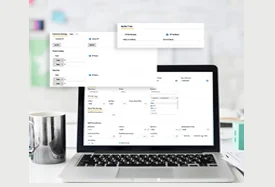
5 Proven Ways to Reduce Payroll Processing Costs
Posted on 11 July 2023 in Business by QuickHR | Suki Bajaj
Did you know that 60% or more of the businesses’ operating costs are typically spent on payroll? Payroll-related spending, such as compensating employees, fixing errors, and managing payroll itself, is often an organisation’s largest expense.
Figuring out the best way to cut down on payroll costs can be mind-boggling, even for seasoned HR professionals. But no worries – we're here to help! We’ve compiled a list of tips that can help you reduce unnecessary payroll costs without having to lower salaries or lay off employees.
Before we jump into the best practices on reducing payroll expenses, let’s talk about what exactly are payroll costs and what’s typical for most businesses?
What is Included in Payroll Costs?
The first step to reducing payroll costs is to get a clear picture of the overall expenses. Labour costs are typically the first thing that comes to mind when talking about payroll expenses.
Wages, salaries, overtime, bonuses, taxes, and benefits all make up a significant portion of total payroll expenses.
While they’re often considered as ‘justified business expenses’, there are many other factors to consider when looking for ways to reduce them.
Best Ways to Reduce Payroll Processing Costs
Here we’ve listed out the smartest ways that will help you effectively cut down the payroll costs without negatively impacting your employees.
Pay Employees Based on the Actual Hours Worked, Not Scheduled Hours
When calculating monthly salary payments, using your employees’ scheduled hours instead of tracking the actual time they’ve worked can be more convenient. However, this method could lead to you spending more money than necessary.
For instance, during a workday, there are common occurrences that may happen such as employees arriving late, leaving early, running personal errands, or taking extended break times.
When you pay your employees based on their scheduled hours, you’re not accounting for any of these gaps. This can lead to overpaying employees for time they did not work, as well as underpaying them for time they did work.
This doesn't mean that your employees have to be working at all times. They can still take breaks and do other things that are allowed by your company policy. However, you may want to track their time more accurately to make sure that they’re not abusing these privileges.
Tracking employee's actual work hours and compensating them accordingly can substantially lower labour costs.
Take note that if you decide to change your pay structure, be sure to communicate this change to your employees and be consistent in your implementation.
Pro Tip: Using a Time and Attendance Management Software that allows you to automatically track the actual hours that your employees worked and generate each time log can help easily streamline the whole process.
This way, you can pay them accurately and avoid overpaying them for time that they’re not working.
Optimise Your Staffing Levels and Scheduling Arrangements
Reducing work hours can be a viable option that may be worth considering if your company is truly in need of cutting costs. Cutting back on overtime hours can also have a major impact on alleviating payroll expenses.
[Public] In some cases where overtime is unavoidable, it may actually mitigate the costs to hire a part-time worker. Hiring temporary employees can help reduce expensive overtime costs during peak seasons.
This is because newer temporary staff can often be paid less than veteran staff, and they can be trained to perform a variety of tasks, which allows them to cover more shifts.
By comparing your staffing levels and scheduling arrangements to your average revenue, you can make informed decisions about how to allocate your resources more effectively.
Keep in mind that it’s important to weigh the pros and cons of every option before making a final decision.
Pro Tip: Use an Employee Scheduling Software to identify any unnecessary overtime. It allows you to cross-reference and easily compare labour costs on the fly so you can adequately assign staff for each shift.
Track Expense Reimbursements
Did you know that nearly half of business travellers fail to adhere to their company's travel policies? This means that they may book flights, join airline lounges, or stay in hotels that are not affiliated with the company or outside of the company’s preferences.
In some cases, employees may try to purchase non-work-related items, such as alcohol and entertainment, and then submit expense reports for reimbursement. Any oversights in the process can lead to employees being paid for expenses that do not meet company policy.
When your employees use company funds, make sure to ask for receipts, review all goods and services they purchased, and that they’re using the budget for business-related purposes only.
Reimbursing expenses through payroll is a common practice for most businesses. As a result, reducing unnecessary expense reimbursements can help lower payroll-related costs.
Pro tip: With a Claim Management System, you can implement a clear and concise system in place for tracking and approving reimbursable expenses and ensure that employees are only reimbursed for expenses that are in line with company policy.
Focus On Cross-Training Employees
By cross training your staff, you can build a versatile and highly skilled workforce that can take on multiple tasks. This can be a valuable way to eliminate the need to hire additional employees, which can help cut down on payroll costs.
In addition, it can also improve employee morale and engagement, which can have a positive impact on the company’s brand image.
Moreover, early and frequent cross-training can help businesses safeguard their best practices, culture, and workplace procedures by ensuring that vital knowledge and skills are not lost when key employees leave.
Automate Payroll with an HRMS Software
Manual payroll processing can be a complex and error-prone method, as there are many ever-evolving laws and regulations to adhere to, and even minor errors can lead to costly fines.
Fortunately, adapting advanced HR solutions such as payroll software has made it easier than ever to automate payroll processes and ensure accuracy and compliance each pay period. This eventually leads to significant cost savings in the long run.
Installing and implementing new technology can be a challenge at first, as it requires employees to learn how to use it and adapt to the changes. But it will definitely be beneficial in the long run and help develop business growth.
Using a reliable payroll software like QuickHR can help eliminate the risk of payroll errors, penalties, and other potential expenses.
How QuickHR Can Help Reduce Payroll Processing Costs
QuickHR’s all-inclusive payroll software can help reduce payroll processing costs in a number of ways, including:
- Automating manual tasks involved in payroll processing such as calculating wages, deductions, and taxes, tracking employee hours, generating payslips, and more. This can help save time and money and reduce errors, as it eliminates the need to hire and pay a dedicated payroll clerk.
- Providing accurate salary distribution in compliance with all applicable laws and regulations helps to avoid legal complications and costly penalties.
- Providing in-depth reporting and analytics helps identify areas where costs can be reduced, or efficiencies can be improved
The specific cost savings that can be achieved by using payroll software will vary depending on the size and complexity of the business. However, in general, businesses can expect to save a significant amount of time and money by automating their payroll processes.
What and How Are Payroll Software Providers Charging Their Clients?
Payroll Software Service providers charge depending on several factors including but not limited to:
- Total number of employees in the payroll
- Frequency of employees’ payout
- Tracking of hours rendered and corresponding rate
- Distribution of pay slips
- Computation of overtime
- Leave management system
- In-depth and thorough monthly payroll reporting
- Selected modules
Payroll providers usually offer different packages for businesses to choose from. It can range from basic to extensive coverage.
If you want to know more about it, feel free to request a demo with absolutely no terms and conditions!
Enjoying this article? Subscribe now and never miss out on future content.
































































































































